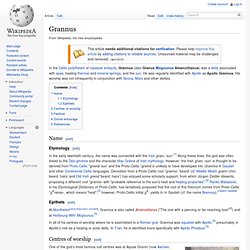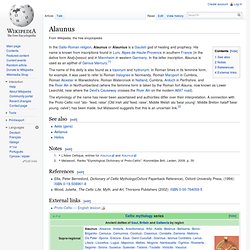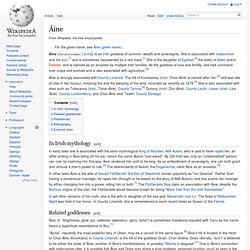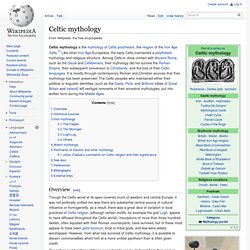

Mug Ruith. Mug Ruith (or Mogh Roith, "slave of the wheel") is a figure in Irish mythology, a powerful blind druid of Munster who lived on Valentia Island, County Kerry.

He could grow to enormous size, and his breath caused storms and turned men to stone. He wore a hornless bull-hide and a bird mask, and flew in a machine called the roth rámach, the "oared wheel". He had an ox-driven chariot in which night was as bright as day, a star-speckled black shield with a silver rim, and a stone which could turn into a poisonous eel when thrown in water. Stories about Mug Ruith are set in various periods of Irish history. Some say he lived during the reign of 3rd century High King Cormac mac Airt, while others put him in Jerusalem during the time of Christ.
The various medieval legends about his adventures in the Holy Land at the dawn of Christendom paint him as an interesting and mysterious character. The territory Mug Ruith received for his descendants was Fir Maige Féne, later known as Fermoy. Lugh. 1905 illustration of Lugh's bloodthirsty magical spear by H.

R. Millar. Grannus. Name[edit] Etymology[edit] In the early twentieth century, the name was connected with the Irish grian, ‘sun’.[1] Along these lines, the god was often linked to the Deò-ghrèine and the character Mac Gréine of Irish mythology.

However, the Irish grian, ‘sun’ is thought to be derived from Proto-Celtic *greinā ‘sun’ and the Proto-Celtic *greinā is unlikely to have developed into Grannos in Gaulish and other Continental Celtic languages. Derivation from a Proto-Celtic root *granno- ‘beard’ (cf. Epithets[edit] At Monthelon[disambiguation needed], Grannus is also called Amarcolitanus ("The one with a piercing or far-reaching look"[4]) and at Horbourg-Wihr Mogounus.[5] In all of his centres of worship where he is assimilated to a Roman god, Grannus was equated with Apollo,[5] presumably in Apollo’s role as a healing or solar deity.
Centres of worship[edit] Hot springs such as those at Aquae Granni (today's Aachen) are thought to have been dedicated to Grannus. Étaín. Étaín (modern spelling: Éadaoin) is a figure of Irish mythology, best known as the heroine of Tochmarc Étaíne (The Wooing Of Étaín), one of the oldest and richest stories of the Mythological Cycle.

She also figures in the Middle Irish Togail Bruidne Dá Derga (The Destruction of Da Derga's Hostel). T. F. O'Rahilly identified her as a sun goddess. Alaunus. The etymology of the name has never been ascertained and authorities differ over their interpretation.

A connection with the Proto-Celtic root *alo- 'feed, raise' (Old Irish alid 'feed, raise', Middle Welsh alu 'bear young', Middle Breton halaff 'bear young, calve') has been made, but Matasović suggests that this is an uncertain link.[2] See also[edit] Notes[edit] Jump up ^ L'Arbre Celtique, entries for Alaunus and Alaunius.Jump up ^ Matasović, Ranko "Etymological Dictionary of Proto-Celtic". Kloninklijke Brill, Leiden, 2009. p. 30. Áine. Áine (Irish pronunciation: [ˈaːnʲə]) is an Irish goddess of summer, wealth and sovereignty.

She is associated with midsummer and the sun,[1] and is sometimes represented by a red mare.[1] She is the daughter of Egobail,[2] the sister of Aillen and/or Fennen, and is claimed as an ancestor by multiple Irish families. As the goddess of love and fertility, she had command over crops and animals and is also associated with agriculture.[2] Áine is strongly associated with County Limerick. The hill of Knockainey (Irish: Cnoc Áine) is named after her,[2] and was site of rites in her honour, involving fire and the blessing of the land, recorded as recently as 1879.[3] She is also associated with sites such as Toberanna (Irish: Tobar Áine), County Tyrone;[4] Dunany (Irish: Dun Áine), County Louth; Lissan (Irish: Lios Áine), County Londonderry; and Cnoc Áine near Teelin, County Donegal.
Celtic mythology. Overview[edit] Though the Celtic world at its apex covered much of western and central Europe, it was not politically unified nor was there any substantial central source of cultural influence or homogeneity; as a result, there was a great deal of variation in local practices of Celtic religion (although certain motifs, for example the god Lugh, appear to have diffused throughout the Celtic world).

Inscriptions of more than three hundred deities, often equated with their Roman counterparts, have survived, but of these most appear to have been genii locorum, local or tribal gods, and few were widely worshipped. However, from what has survived of Celtic mythology, it is possible to discern commonalities which hint at a more unified pantheon than is often given credit.